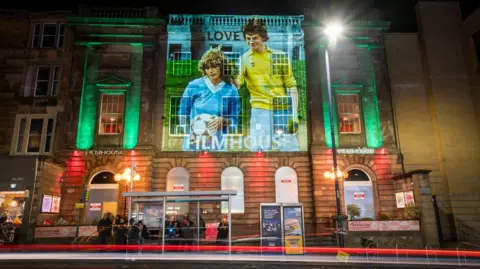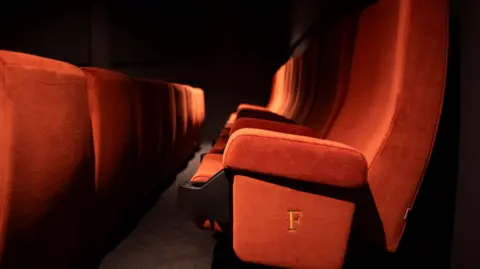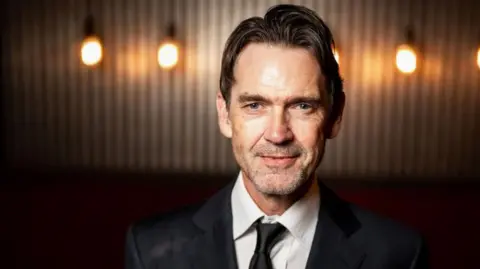Filmhouse saviours tell public: 'It's yours now - look after it'
 PA Media
PA MediaEdinburgh-born filmmaker Charlotte Wells was delighted when her debut film Aftersun was chosen as the opening film of the 2022 Edinburgh International Film Festival (EIFF).
Although it had premiered in Cannes and would go on to earn actor Paul Mescal an Oscar nomination, this was an important moment for a film director who had grown up in the city.
"It was an incredibly special night and I was able to dedicate that screening to a teacher that I had in school who had a big impact on me," she recalls.
"It was the first time that many of my friends and family understood what I did, so it was a night of celebration and homecoming."
 Getty Images
Getty ImagesBut just weeks later in October 2022 the film festival, Filmhouse and the Belmont cinema in Aberdeen all closed abruptly after their parent company The Centre for the Moving Image (CMI) went into administration.
CMI blamed the pandemic, cost of living and a fall in cinema attendance for the closure.
"I almost felt like some responsibility for it, you know, having been that opening night film," says Charlotte.
"And I think that's where everybody, myself included, probably realised the degree to which we take these cultural institutions for granted. And we realised we had to do something."
A group of former Filmhouse staff had already come to the same conclusion.
Among them, head of programming Rod White, who'd worked there for 20 years but had been coming to the cinema since he was a student in the 1980s.
"It was a huge part of my life and a completely essential place for those interested in the kind of cinema that perhaps didn't play at the multiplex," he says.
"There's a whole load of things that just wouldn't see the light of day."
"For me, it would be utterly absurd if there was no cinema that does what Filmhouse does in Scotland's capital city. "
 Kat Gollock
Kat GollockHe soon found other like-minded people - including retired film festival managing director Ginnie Atkinson - and launched a crowdfunder with the hope of buying the former church which has housed Filmhouse for nearly 50 years.
"It seemed like the only option at the time and the incredible support we had was galvanising," says Ginnie.
But despite A-list support from Jack Lowden, Brian Cox, Dame Emma Thompson and Dougray Scott and thousands of donations, they were unable to raise enough money and the building was sold to a developer who planned to open a themed pub.
Realising the new owners were unlikely to obtain an alcohol licence for that part of Edinburgh, the Filmhouse campaigners approached local pub owners Caledonian Heritable, and asked if the company would consider buying the building and leasing it to them as a cinema complex.
"They gave us six months to see if we could raise the money and lease it from them," says Ginnie.
The Filmhouse enthusiasts set up a new charity and launched a fresh crowdfunding campaign. But the game changing moment was an award in March 2024 from the UK government's community ownership fund of £1.5m.
 Kat Gollock
Kat Gollock Kat Gollock
Kat GollockThat, along with the crowdfunded pot of £324,000 and further support from Screen Scotland, Creative Scotland and City of Edinburgh Council, meant they were able to begin the transformation.
"The layout of the building will be quite familiar to people who've been here before, so screens one, two and three and the bar are still in the same place but they are completely refurbished," says executive director Andrew Simpson.
"New seats, extra legroom, still the same brilliant standard of film presentation but comfier and cosier and the best version of screen one that has ever been at Filmhouse and that's the same for screens two and three and four."
The fourth screen - a 24 seat space - will open at the end of July and be available for private hire. It's hoped the EIFF - which has also gradually returned - will come back to the venue, although the organisations are now entirely separate.
Some things remain the same, including the projection room capable of showing 8mm, 16mm, 35mm and 70mm celluloid film. The Filmhouse is among a handful of cinemas able to show almost any format.
 Getty Images
Getty ImagesFor actor Dougray Scott, who campaigned to save Filmhouse, it's an important part of the cultural landscape.
"I always associated the Filmhouse with independent films and it was also the heart of the Edinburgh film festival. I was there with Enigma one year and it just holds such a special place in my heart," he says.
He recognises the challenges cinema continues to face from television and streaming platforms.
"I think all filmmakers have that dilemma now where they're thinking that if Netflix or Apple or whoever it is, is paying for this movie it'll eventually be shown on that.
"But I think there's a way to make it for both mediums so that you know someone's going to come and watch it in a cinema with a huge screen and you bear that in mind when you're setting up your camera angles and the lenses you choose and how you tell that story.
"It's a very different experience."
"For me, going to the cinema, sitting in the darkness, you just get lost in that world for two hours. It's an escape but it's also a portal into every culture in the world. "
He, like Charlotte Wells, no longer lives in Scotland. So they're reliant on the local community to keep the doors of Filmhouse open.
"The energy we received during the crowdfunding campaign really feels like it's spun out into our pre-opening period," says Andrew Simpson.
"We've already hit our target for membership sales for the whole of the first year and we've sold something like two and a half thousand tickets to our opening week programme in what's not an easy time of year for cinemas like ours."
 Kat Gollock
Kat Gollock Kat Gollock
Kat GollockMuch of their programme will be devoted to the films they missed during the three year closure. On Sunday, that includes Make it To Munich, a feel-good documentary about a teenager on an 800 mile cycle to the Euros after a near fatal accident.
It has resonance for those who've championed Filmhouse from the start.
"It's incredible," says Rod White, who has returned to his old job as head of programming.
"This place has been a very depressing space for the last two-and-a-half years, through three winters of damp and decay in some places. So to see it now full of new staff ready to reopen is very moving. It's been a long road, but we're there."
Ginnie Atkinson says she's happy to return to retirement and let the community take over.
"We just sent out the final crowdfunder update and we said 'this is yours now, you've contributed, you've paid for it, it's yours. Enjoy it and look after it and love it'," she says.
